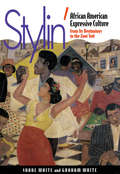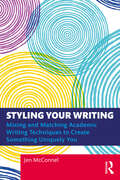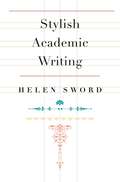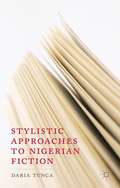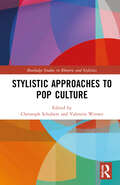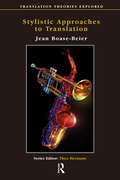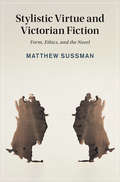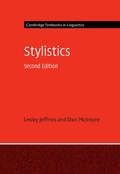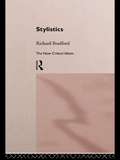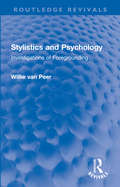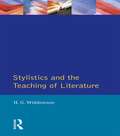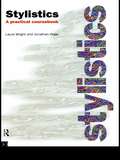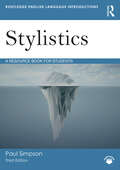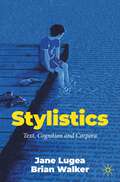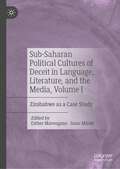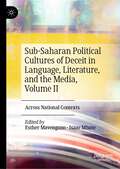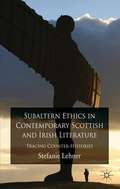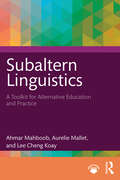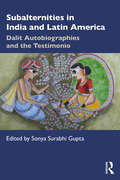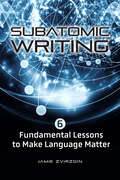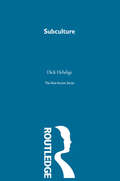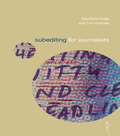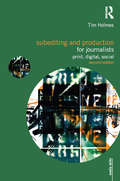- Table View
- List View
Stylin': African-American Expressive Culture, from Its Beginnings to the Zoot Suit
by Shane White Graham WhiteFor over two centuries, in the North as well as the South, both within their own community and in the public arena, African Americans have presented their bodies in culturally distinctive ways. Shane White and Graham White consider the deeper significance of the ways in which African Americans have dressed, walked, danced, arranged their hair, and communicated in silent gestures. They ask what elaborate hair styles, bright colors, bandanas, long watch chains, and zoot suits, for example, have really meant, and discuss style itself as an expression of deep-seated cultural imperatives. Their wide-ranging exploration of black style from its African origins to the 1940s reveals a culture that differed from that of the dominant racial group in ways that were often subtle and elusive. A wealth of black-and-white illustrations show the range of African American experience in America, emanating from all parts of the country, from cities and farms, from slave plantations, and Chicago beauty contests. White and White argue that the politics of black style is, in fact, the politics of metaphor, always ambiguous because it is always indirect. To tease out these ambiguities, they examine extensive sources, including advertisements for runaway slaves, interviews recorded with surviving ex-slaves in the 1930s, autobiographies, travelers' accounts, photographs, paintings, prints, newspapers, and images drawn from popular culture, such as the stereotypes of Jim Crow and Zip Coon.
Styling Your Writing: Mixing and Matching Academic Writing Techniques to Create Something Uniquely You
by Jen McConnelThis text helps developing writers in the academy and beyond think through their writing process and develop strategies for styling their writing to meet the demands of a wide range of goals. The book imagines writing as an assortment of "outfits"— bundles of styles and strategies through which one approaches a writing purpose, such as writing focused on experimentation and growth or writing focused on a professional task. By assessing the outfits writers feel most and least confident in, and examining how to be more at home in the outfits that matter to them, this book helps students develop both specific skills and their overall identity as writers. Readers are guided through before-, during-, and after-writing strategies and techniques, including: freewriting, outlining, visual planning, and composing in multimodal forms. Readers are also introduced to the importance of setting clear writing goals and sharing their work in a variety of ways, both in preparation for classroom success through peer review and writing center visits, and beyond the classroom in virtual and in-person spaces. This book serves as a core or supplemental text for writing courses at the undergraduate, graduate, or high school level, or as a writing guide for individual readers.
Stylish Academic Writing
by Helen SwordElegant data and ideas deserve elegant expression, argues Helen Sword in this lively guide to academic writing. For scholars frustrated with disciplinary conventions, and for specialists who want to write for a larger audience but are unsure where to begin, here are imaginative, practical, witty pointers that show how to make articles and books a pleasure to read—and to write.Dispelling the myth that you cannot get published without writing wordy, impersonal prose, Sword shows how much journal editors and readers welcome work that avoids excessive jargon and abstraction. Sword’s analysis of more than a thousand peer-reviewed articles across a wide range of fields documents a startling gap between how academics typically describe good writing and the turgid prose they regularly produce.Stylish Academic Writing showcases a range of scholars from the sciences, humanities, and social sciences who write with vividness and panache. Individual chapters take up specific elements of style, such as titles and headings, chapter openings, and structure, and close with examples of transferable techniques that any writer can master.
Stylistic Approaches to Nigerian Fiction
by Daria TuncaDrawing on the discipline of stylistics, this book introduces a series of methodological tools and applies them to works by well-known Nigerian writers, including Abani, Adichie and Okri. In doing so, it demonstrates how attention to form fosters understanding of content in their work, as well as in African and postcolonial literatures more widely.
Stylistic Approaches to Pop Culture (Routledge Studies in Rhetoric and Stylistics)
by Christoph SchubertThis collection showcases the unique potential of stylistic approaches for better understanding the multifaceted nature of pop culture discourse. As its point of departure, the book takes the notion of pop culture as a phenomenon characterized by the interaction of linguistic signs with other modes such as imagery and music to examine a diverse range of genres through the lens of stylistics. Each section is grouped around thematic lines, looking at literary fiction, telecinematic discourse, music and lyrics, as well as cartoons and video games. The 12 chapters analyze different forms of media through five central strands of stylistics, from sociolinguistic, pragmatic, cognitive, multimodal, to corpus-based approaches. In drawing on these various stylistic frameworks and applying them across genres and modes, the contributions offer readers deeper insights into the role of scripted and performed language in social representation and identity construction, thereby highlighting the affordances of stylistics research in studying pop cultural texts. This volume is of particular interest to students and researchers in stylistics, linguistics, literary studies, media studies, and cultural studies.
Stylistic Approaches to Translation (Translation Theories Explored #Vol. 10)
by Jean Boase-BeierThe concept of style is central to our understanding and construction of texts. But how do translators take style into account in reading the source text and in creating a target text? This book attempts to bring some coherence to a highly interdisciplinary area of translation studies, situating different views and approaches to style within general trends in linguistics and literary criticism and assessing their place in translation studies itself. Some of the issues addressed are the link between style and meaning, the interpretation of stylistic clues in the text, the difference between literary and non-literary texts, and more practical questions about the recreation of stylistic effects. These various trends, approaches and issues are brought together in a consideration of the most recent cognitive views of style, which see it as essentially a reflection of mind. Underlying the book is the notion that knowledge of theory can affect the way we translate. Far from being prescriptive, theories which describe what we know in a general sense can become part of what an individual translator knows, thus opening the way for greater awareness and also greater creativity in the act of translation. Throughout the discussion, the book considers how insights into the nature and importance of style might affect the actual translation of literary and non-literary texts.
Stylistic Virtue and Victorian Fiction: Form, Ethics, and the Novel (Cambridge Studies in Nineteenth-Century Literature and Culture #130)
by Matthew SussmanWhat is style, and why does it matter? This book answers these questions by recovering the concept of 'stylistic virtue,' once foundational to rhetoric and aesthetics but largely forgotten today. Stylistic virtues like 'ease' and 'grace' are distinguishing properties that help realize a text's essential character. First described by Aristotle, they were integral to the development of formalist methods and modern literary criticism. The first half of the book excavates the theory of stylistic virtue during its period of greatest ascendance, in the late eighteenth and nineteenth centuries, when belletristic rhetoric shaped how the art of literary style and 'the aesthetic' were understood. The second half offers new readings of Thackeray, Trollope, and Meredith to show how stylistic virtue changes our understanding of style in the novel and challenges conventional approaches to interpreting the ethics of art.
Stylistics
by Lesley Jeffries Dan McintyreStylistics is the linguistic study of style in language. It aims to account for how texts project meaning, how readers construct meaning and why readers respond to texts in the way that they do. This book is an introduction to stylistics that locates it firmly within the traditions of linguistics. Organised to reflect the historical development of stylistics from its origins in Russian formalism, the book covers key principles such as foregrounding theory, as well as more recent developments in cognitive stylistics. It includes an examination of both literary and non-literary texts, and substantial coverage of methodologies for stylistic analysis. Throughout the book, the emphasis is on the practicalities of producing stylistic analyses that are objective, replicable and falsifiable. Comprehensive in its coverage and assuming no prior knowledge of the topic, Stylistics will be essential reading for undergraduate and graduate students new to this fascinating area of language study.
Stylistics (Cambridge Textbooks in Linguistics)
by Lesley Jeffries Dan McIntyreStylistics is the linguistic study of style in language. Now in its second edition, this book is an introduction to stylistics that locates it firmly within the traditions of linguistics. Organised to reflect the historical development of stylistics, it covers key principles such as foregrounding theory, as well as recent advances in cognitive and corpus stylistics. This edition has been fully revised to cover all the major developments in the field since the first edition, including extensive coverage of corpus stylistics, new sections on a range of topics, additional exercises and commentaries, updated further reading lists, and an entirely re-written final chapter on the disciplinary status of stylistics and its relationship to linguistics, plus a manifesto for the future of the field. Comprehensive in its coverage and assuming no prior knowledge of the subject, it is essential reading for students and researchers new to this fascinating area of language study.
Stylistics (The New Critical Idiom)
by Richard BradfordRichard Bradford provides a definitive introductory guide to modern critical ideas on literary style and stylistics. It will provide students with a basic grasp of stylistics and literary analysis.This comprehensive and accessible guidebook for undergraduates examines:* the terminology of literary form* how literary style has evolved since the sixteenth century* the role of stylistics in twentieth century criticism* the discipline of stylistics from classical rhetoric to post-structuralism* the relationship between literary style and its historical context* style and gender* examples of poems, plays and novels from Shakespeare to the present day.
Stylistics and Psychology: Investigations of Foregrounding (Routledge Revivals)
by Willie Van PeerFirst published in 1986, Stylistics and Psychology is an empirical investigation into foregrounding. The theory of foregrounding has received little in the way of empirical testing within the field of stylistics and literary criticism. The book engages extensively with the author’s own research involving psychological testing and provides a rigorous, scientific approach to stylistics. It presents evidence of a general link between foregrounding and evaluation, apparent in correlations between foregrounding and evaluation, between foregrounding and reader preference, and between foregrounding and readers’ evaluative associations. Stylistics and Psychology will appeal to those with an interest in literary criticism and linguistics.
Stylistics and the Teaching of Literature (Applied Linguistics and Language Study)
by H. G. WiddowsonFirst published in 1976. Routledge is an imprint of Taylor & Francis, an informa company.
Stylistics: A Practical Coursebook
by Laura Wright Jonathan HopeUsing a wide range of twentieth-century literary prose Laura Wright and Jonathan Hope provide an `interactive' introduction to the techniques of stylistic analysis. Divided up into five sections; the noun phrase, the verb phrase, the clause, text structure and vocabulary, the book also provides an introduction to the basics of descriptive grammar for beginning students. * Presumes no prior linguistic knowledge * Provides a comprehensive glossary of terms * Adaptable: designed to be used in a variety of classroom contexts * Introduces students to an enormous range of 20th century literature from James Joyce to Roddy Doyle A practical coursebook rather than a survey account of stylistics as a discipline, the book provides over forty opportunities for hands-on stylistic analysis. For each linguistic feature under discussion the reader is offered a definition, a text for analysis, exercises and tasks, in addition to a suggested solution. Stylistics: A Practical Coursebook is genuinely `student friendly' and will be an invaluable tool for all beginning undergraduates and A-level students of language and literature.
Stylistics: A Resource Book for Students (Routledge English Language Introductions)
by Paul SimpsonWritten in a clear and accessible style, Stylistics, Third Edition is a comprehensive resource which covers all the major theories, concepts and methods required for the investigation of language in literature. From metre to metaphor, dialogue to discourse, the main topics are introduced and fully elaborated, as are the key research paradigms of this important and exciting field of study. Stylistics is richly illustrated with many examples from literary texts, including writing from the established literary canon alongside more contemporary work in poetry, prose and drama. Each of the book’s 12 chapters contains clearly framed suggestions for practical work and is accompanied by an original reading on the relevant topic by a world-renowned scholar.This exciting new third edition builds on the strengths of the first and second by adding fresh exercises and worked examples. It captures the major developments in stylistics, from earlier work that draws on syntax, semantics and phonology, to more recent approaches such as corpus, cognitive and multimodal approaches to the study of style. The accompanying online materials feature, amongst other things, useful links, worked examples and a strand on style and humour. This third edition brings in more texts from contemporary women writers and from writing in more diverse ‘Englishes’. In addition to the classic essays in stylistics contained in previous editions, this edition includes three new Section D readings to reflect more recent innovations in the field.Written by an experienced teacher and researcher, this accessible textbook is an essential resource for all students of English language, linguistics and literature.
Stylistics: Text, Cognition and Corpora
by Brian Walker Jane LugeaThis textbook introduces the reader to contemporary approaches to language analysis such as cognitive stylistics and corpus stylistics, reflecting recent shifts in research trends and offering students a practical way to access and understand these developments. The authors lead readers through detailed explanations, guided analyses, examples of research and suggestions for further reading. This textbook makes an ideal introduction to the field of stylistics for students who are new to the area, but who have some background in basic language analysis. It will be of use to students on courses in stylistics, literary linguistics, corpus methods, cognitive linguistics, and language and style.
Sub-Saharan Political Cultures of Deceit in Language, Literature, and the Media, Volume I: Zimbabwe as a Case Study
by Isaac Mhute Esther MavenganoThis two-volume set charts a cross-disciplinary discursive terrain that proffers rich insights about deceit in contemporary postcolonial Sub-Saharan African politics. In an attempt to produce a nuanced and multi-faceted academic dialoguing platform, the two volumes have a particular focus on the aspects of treachery, fear of difference (oppositional politics), and discourses/ semiotics of mis/self- representation. The major aim of the proposed volumes is to contribute toward the often problematised conversations about the unfolding (post)colonial Sub-Saharan world which is topical in decolonial and Pan-African studies. The volumes seek to place political thinking and postcolonial political systems under the scholarly gaze with the view to highlight and enhance the participation of African cross-disciplinary scholarship in the postcolonial political processes of the continent. Most significantly, it is through such probing of the limitations of our own disciplinary perspectives which can help us appreciate the complexity of the postcolonial Sub-Saharan African politics. The first volume uses Zimbabwe as a case study, while the second volume broadens to examine postcolonial politics in Sub-Saharan Africa more broadly.
Sub-Saharan Political Cultures of Deceit in Language, Literature, and the Media, Volume II: Across National Contexts
by Isaac Mhute Esther MavenganoThis two-volume set charts a cross-disciplinary discursive terrain that proffers rich insights about deceit in contemporary postcolonial Sub-Saharan African politics. In an attempt to produce a nuanced and multifaceted academic dialoguing platform, the two volumes have a particular focus on the aspects of treachery, fear of difference (oppositional politics), and discourses/semiotics of mis/self-representation. The major aim of the proposed volumes is to contribute toward the often problematised conversations about the unfolding (post)colonial Sub-Saharan world which is topical in decolonial and Pan-African studies.The volumes seek to place political thinking and postcolonial political systems under the scholarly gaze with the view to highlight and enhance the participation of African cross-disciplinary scholarship in the postcolonial political processes of the continent. Most significantly, it is through such probing of the limitations of our own disciplinary perspectives which can help us appreciate the complexity of the postcolonial Sub-Saharan African politics. The first volume uses Zimbabwe as a case study, while the second volume examines postcolonial politics in Sub-Saharan Africa more broadly.The first volume uses Zimbabwe as a case study, while the second volume examines postcolonial politics in Sub-Saharan Africa more broadly.The first volume uses Zimbabwe as a case study, while the second volume examines postcolonial politics in Sub-Saharan Africa more broadly.
Subaltern Ethics in Contemporary Scottish and Irish Literature
by Stefanie LehnerRecent decades have not only seen an increasing interest in the political and economic crosscurrents between Scotland and Ireland, but they have also witnessed a remarkable literary renaissance on both sides of the Irish Sea. Subaltern Ethics breaks new ground in theoretical investigations of the overlapping of Irish and Scottish studies. Its approach galvanises Emmanuel Levinas' ethics with the socio-cultural category of the 'subaltern' to arrive at a rigorous position of politicised postcolonial theory. This innovative Irish-Scottish comparative framework enables Stefanie Lehner to trace a shared matrix of politico-ethical concerns in contemporary Scottish, Northern Irish and Irish writings. The book sheds new light on established and more recent writers, including James Kelman, Patrick McCabe and Glenn Patterson, exploring how their fictions interact with recent political developments, concerning the impact of the Celtic Tiger in the Republic, devolution in Scotland, and the peace process in Northern Ireland. It argues that these works register a recalcitrance towards dominant historical paradigms, thereby constructing 'counter-histories' to the alleged (d)evolutionary processes in today's Atlantic archipelago.
Subaltern Linguistics: A Toolkit for Alternative Education and Practice
by Ahmar Mahboob Aurelie Mallet Lee Cheng KoaySubaltern Linguistics challenges the goals and theoretical foundations of colonial linguistics, academia, and education and provides alternative approaches and practices. The goal of subaltern practice is to create economies, projects, and resources that can be made and used by community members and leaders to develop and promote community beneficial projects in their own language (or a language of their choice). In doing subaltern and CREDIBLE work, we need to develop a new array of tools and resources. This book provides a broad introduction for how this can be done along with examples of multiple CREDIBLE projects carried out by students and members of the broader community.Part I establishes the need for this work, introduces some concepts that the CREDIBLE approach draws on, and explains CREDIBLE projects. Part II delineates what can be done while adopting a CREDIBLE approach, including several examples of student projects across a range of areas such as education, environment, healthcare and economic development. Part III provides detailed guidelines and instructions on how to develop CREDIBLE projects with worksheets and activities that can be used to conceptualise, plan, and develop CREDIBLE projects. Finally, Part IV includes four CREDIBLE project reports as examples of how this work can be written up for wider dissemination.This text is an essential guide to a new way of doing linguistics, reflecting the diversity and richness of today’s world.
Subalternities in India and Latin America: Dalit Autobiographies and the Testimonio
by Sonya Surabhi GuptaThis volume presents a comparative exploration of Dalit autobiographical writing from India and of Latin American testimonio as subaltern voices from two regions of the Global South. Offering frames for linking global subalternity today, the chapters address Siddalingaiah’s Ooru Keri; Muli’s Life History; Manoranjan Byapari and Manju Bala’s narratives; and Yashica Dutt’s Coming Out as Dalit; among others, alongside foundational texts of the testimonio genre. While embedded in their specific experiences, the shared history of oppression and resistance on the basis of race/ethnicity and caste from where these subaltern life histories arise constitutes an alternative epistemological locus. The chapters point to the inadequacy of reading them within existing critical frameworks in autobiography studies. A fascinating set of studies juxtaposing the two genres, the book is an essential read for scholars and researchers of Dalit studies, subaltern studies, testimonio and autobiography, cultural studies, world literature, comparative literature, history, political sociology and social anthropology, arts and aesthetics, Latin American studies, and Global South studies.
Subatomic Writing: Six Fundamental Lessons to Make Language Matter
by Jamie ZvirzdinSee science writing fundamentals afresh through a subatomic lens!In Subatomic Writing, Johns Hopkins University instructor Jamie Zvirzdin goes bravely into uncharted territory by offering a totally new kind of guide for writing about science—from the subatomic level up! Subatomic Writing teaches readers that the building blocks of language are like particles in physics. These particles, combined and arranged, form something greater than their parts: all matter in the literary universe. The six levels of language covered in this guide create writing that illuminates and energizes the reader to feel, learn, change, and act. This interdisciplinary approach helps scientists, science writers, and editors improve their writing in fundamental areas as they build from the sounds in a word to the pacing of a paragraph. These areas include• Sound and sense• Word classes• Grammar and syntax• Punctuation• Rhythm and emphasis• Pacing and coherenceEqually helpful for students who need to learn how to write clearly about science and scientists who need to hone their writing skills to create more effective course material, papers, and grant applications, this guide builds confidence in writing abilities as old skills are taught in new, exciting ways. Each lesson provides exercises that build on each other, strengthening readers' capacity to communicate ideas and data, all while learning basic particle physics along the way.
Subculture: The Meaning Of Style (New Accents Ser.)
by Dick HebdigeFirst Published in 2002. Routledge is an imprint of Taylor & Francis, an informa company.
Subediting and Production for Journalists: Print, Digital & Social
by Tim Holmes Wynford HicksSubediting for Journalists is a concise, up-to-date and readable introduction to the skills of subediting for newspapers and magazines. It describes how subediting has developed, from the early days of printing to the modern era of computers and the web, and explains clearly what the sub now has to do.Using practical examples from newspapers and magazines, Subediting for Journalists introduces the various techniques involved in subediting from cutting copy to writing cover lines. It includes:*house style explained with model stylebook provided*examples of bad journalistic English such as misused clichés and pronoun confusion*subbing news and features for sense and style*editing quotes and readers' letters*projecting copy by writing headlines and standfirsts*checking pictures and writing captions*principles and methods of proofreading*making copy legally safe*understanding production and using software packages *website subbing*a glossary of journalistic terms and suggestions for further reading
Subediting and Production for Journalists: Print, Digital & Social (Media Skills)
by Tim HolmesThe new edition of Subediting and Production for Journalists is a concise, clear and contemporary introduction to the skills required for subediting newspapers, magazines and websites. Tim Holmes describes how subediting has developed, from the early days of print to the modern era of the internet browser and social media, and explores the many challenges for the sub working today. Using numerous practical examples drawn from print and online, Subediting and Production for Journalists introduces the various techniques employed by the sub to help make the written word stand out on the page, including: subbing news and features for sense and style writing headlines and sells making copy legally safe understanding production, using software packages and content management systems editing and rewriting stories for online publication creating suitable page furniture for websites handling and sizing pictures digitally handling audio and video. Subediting and Production for Journalists is the perfect guide for all those with an interest in subbing in today’s multimedia environments, as well as anyone wanting to see their words come to life.
Subhashika Dviteeyo Bhag class 7 - JCERT: सुभाषिका द्वितीयो भागः ७वीं कक्षा - जेसीईआरटी
by Jharkhand Shaikshik Anusandhan Evam Prashikshan Parishad Ranchi"सुभाषिका" द्वितीयो भाग झारखंड शैक्षिक अनुसंधान एवं प्रशिक्षण परिषद द्वारा प्रकाशित संस्कृत की पाठ्यपुस्तक है, जिसका उद्देश्य कक्षा 7 के छात्रों को संस्कृत भाषा का बुनियादी ज्ञान प्रदान करना है। यह पुस्तक विशेष रूप से संस्कृत भाषा की महत्ता और उसकी सांस्कृतिक धरोहर को समझाने पर केंद्रित है। इसमें 16 पाठ शामिल हैं, जिनमें कविताएँ, श्लोक, संवाद, कथाएँ और चित्रकथाएँ सम्मिलित हैं। प्रत्येक पाठ भाषा की सरलता और प्रवाह को ध्यान में रखते हुए तैयार किया गया है, ताकि छात्रों को संस्कृत भाषा से लगाव हो। पुस्तक में "गौरवम् संस्कृतम्" जैसे श्लोकों के माध्यम से संस्कृत भाषा की समृद्धि और गौरव को उजागर किया गया है, जबकि "बुद्धिर्यस्य बलं तस्य" जैसे पाठ बुद्धि की महत्ता पर बल देते हैं। इसके अतिरिक्त, पाठ्यक्रम में झारखंड की सांस्कृतिक विरासत को भी स्थान दिया गया है, जैसे "सरहुल पर्व" और भगवान बिरसा मुण्डा की गाथाएँ। इस पुस्तक का उद्देश्य विद्यार्थियों में संस्कृत भाषा के प्रति रुचि पैदा करना और उनके नैतिक और सांस्कृतिक विकास में योगदान देना है।
